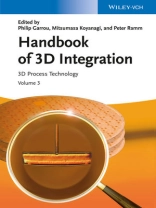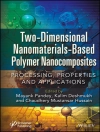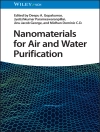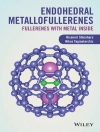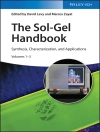Edited by key figures in 3D integration and written by top authors from high-tech companies and renowned research institutions, this book covers the intricate details of 3D process technology.
As such, the main focus is on silicon via formation, bonding and debonding, thinning, via reveal and backside processing, both from a technological and a materials science perspective. The last part of the book is concerned with assessing and enhancing the reliability of the 3D integrated devices, which is a prerequisite for the large-scale implementation of this emerging technology.
Invaluable reading for materials scientists, semiconductor physicists, and those working in the semiconductor industry, as well as IT and electrical engineers.
As such, the main focus is on silicon via formation, bonding and debonding, thinning, via reveal and backside processing, both from a technological and a materials science perspective. The last part of the book is concerned with assessing and enhancing the reliability of the 3D integrated devices, which is a prerequisite for the large-scale implementation of this emerging technology.
Invaluable reading for materials scientists, semiconductor physicists, and those working in the semiconductor industry, as well as IT and electrical engineers.
Table des matières
3D IC INTEGRATION SINCE 20083D IC Nomenclature
Process Standardization
The Introduction of Interposers (2.5D)
The Foundries
Memory
The Assembly and Test Houses
3D IC Application Roadmaps
KEY APPLICATIONS AND MARKED TRENDS FOR 3D INTEGRATION AND INTERPOSER TECHNOLOGIES
Introduction
Advanced Packaging Importance in the Semiconductor Industry is Growing
3D Integration-Focused Activities – The Global IP Landscape
Applications, Technology, and Market Trends
ECONOMIC DRIVERS AND IMPEDIMENTS FOR 2.5D/3D INTEGRATION
3D Performance Advantages
The Economics of Scaling
The Cost of Future Scaling
Cost Remains the Impediment to 2.5D and 3D Product Introduction
INTERPOSER TECHNOLOGY
Definition of 2.5D Interposers
Interposer Drivers and Need
Comparison of Interposer Materials
Silicon Interposers with TSV
Lower Cost Interposers
Interposer Technical and Manufacturing Challenges
Interposer Application Examples
Conclusions
TSV FORMATION OVERVIEW
Introduction
TSV Process Approaches
TSV Fabrication Steps
Yield and Reliability
TSV UNIT PROCESSES AND INTEGRATION
Introduction
TSV Process Overview
TSV Unit Processes
Integration and Co-Optimization of Unit Processes in Via Formation Sequence
Co-Optimization of Unit Processes in Backside Processing and Via-Reveal Flow
Integration and Co-Optimization of Unit Processes in Via-Last Flow
Integration with Packaging
Electrical Characterization of TSVs
Conclusions
TSV FORMATION AT ASET
Introduction
Via-Last TSV for Both D2D and W2W Processes in ASET
TSV Process for D2D
TSV Process for W2W
Conclusions
LASER-ASSISTED WAFER PROCESSING: NEW PERSPECTIVES IN THROUGH-SUBSTRATE VIA DRILLING AND REDISTRIBUTION LAYER DEPOSITION
Introduction
Laser Drilling of TSVs
Direct-Write Deposition of Redistribution Layers
Conclusions and Outlook
TEMPORARY BONDING MATERIAL REQUIREMENTS
Introduction
Technology Options
Requirements of a Temporary Bonding Material
Considerations for Successful Processing
Surviving the Backside Process
Debonding
TEMPORARY BONDING AND DEBONDING – AN UPDATE ON MATERIALS AND METHODS
Introduction
Carrier Selection for Temporary Bonding
Selection of Temporary Bonding Adhesives
Bonding and Debonding Processes
Equipment and Process Integration
ZONEBOND®: RECENT DEVELOPMENTS IN TEMPORARY BONDING AND ROOM-TEMPERATURE DEBONDING
Introduction
Thin Wafer Processing
Zone BOND Room-Temperature Debonding
Conclusions
TEMPORARY BONDING AND DEBONDING AT TOK
Introduction
Zero Newton Technology
Conclusions
THE 3M (TM) WAFER SUPPORT SYSTEM (WSS)
Introduction
System Description
General Advantages
High-Temperature Material Solutions
Process Considerations
Future Directions
Summary
COMPARISON OF TEMPORARY BONDING AND DEBONDING PROCESS FLOWS
Introduction
Studies of Wafer Bonding and Thinning
Backside Processing
Debonding and Cleaning
THINNING, VIA REVEAL, AND BACKSIDE PROCESSING – OVERVIEW
Introduction
Wafer Edge Trimming
Thin Wafer Support Systems
Wafer Thinning
Thin Wafer Backside Processing
BACKSIDE THINNING AND STRESS-RELIEF TECHNIQUES FOR THIN SILICON WAFERS
Introduction
Thin Semiconductor Devices
Wafer Thinning Techniques
Fracture Tests for Thin Silicon Wafers
Comparison of Stress-Relief Techniques for Wafer Backside Thinning
Process Flow for Wafer Thinning and Dicing
Summary and Outlook on 3D Integration
VIA REVEAL AND BACKSIDE PROCESSING
Introduction
Via Reveal and Backside Processing in Via-Middle Process
Backside Processing in Back-Via Process
Backside Processing and Impurity Gettering
Backside Processing for RDL Formation
DICING, GRINDING, AND POLISHING (KIRU KEZURU AND MIGAKU)
Introduction
Grinding and Polishing
Dicing
Summary
OVERVIEW OF BONDING AND ASSEMBLY FOR 3D INTEGRATION
Introduction
Direct, Indirect, and Hybrid Bonding
Requirements for Bonding Process and Materials
Bonding Quality Characterization
Discussion of Specific Bonding and Assembly Technologies
Summary and Conclusions
BONDING AND ASSEMBLY AT TSMC
Introduction
Process Flow
Chip-on-Wafer Stacking
Co W-on-Substrate (Co Wo S) Stacking
Co
A propos de l’auteur
Philip Garrou is a consultant and expert witness in the field of IC packaging materials and applications, prior to which he was Dir. of Technology and Business Dev. for Dow Chemicals’ Electronic Materials business. Dr. Garrou is a Fellow of IEEE and IMAPS and served as President of the IEEE CPMT Society and IMAPS. He has co-authored 3 microelectronics texts and 100+ publications. He is Assoc. Ed. and author of the weekly blog ‘Insights from the Leading Edge’ for Solid State Technology and has co-authored 3DIC reports for both Tech Search and Yole.Mitsumasa Koyanagi is Professor in New Industry Creation Hatchery Center (NICHe) and Director in GINTI (Global Integration Initiative) at Tohoku University, Japan. After his Ph D in electrical engineering he joined the Central Research Laboratory of Hitachi where he was engaged in the research on semiconductor memories. After a three-year stay at the Xerox Palo Alto Research Center in California, USA, he became Professor in the Research Center for Integrated Systems at Hiroshima University, Japan. Mitsumasa Koyanagi received numerous awards, including the IEEE Jun-ichi Nishizawa Medal and the National Medal with Purple Ribbon in Japan.
Peter Ramm is head of the department Heterogeneous System Integration of Fraunhofer EMFT in Munich, Germany, where he is responsible for the key competence ‘Si Processes, Device and 3D Integration’. He received the physics and Dr. rer. nat. degrees from the University of Regensburg and subsequently worked for Siemens in the DRAM facility where he was responsible for the process integration. In 1988 he joined Fraunhofer IFT in Munich, focusing for more than 25 years on 3D integration technologies. Peter Ramm is coauthor of over 100 publications and 24 patents and editor of Wiley´s ‘Handbook of Wafer Bonding’. He received the ‘Ashman Award 2009’ from IMAPS ‘For Pioneering Work on 3D IC Stacking and Integration’.
Achetez cet ebook et obtenez-en 1 de plus GRATUITEMENT !
Langue Anglais ● Format EPUB ● Pages 474 ● ISBN 9783527670123 ● Taille du fichier 40.7 MB ● Éditeur Philip Garrou & Mitsumasa Koyanagi ● Maison d’édition Wiley-VCH ● Publié 2014 ● Édition 1 ● Téléchargeable 24 mois ● Devise EUR ● ID 3250704 ● Protection contre la copie Adobe DRM
Nécessite un lecteur de livre électronique compatible DRM
